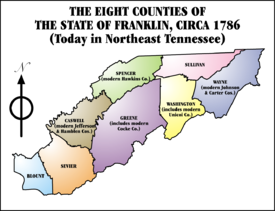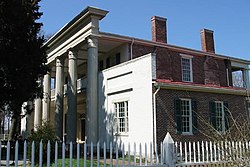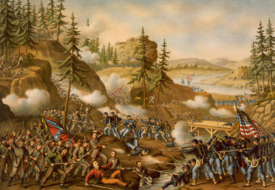History of Tennessee
During the Reconstruction era, the state had competitive party politics, but a Democratic takeover in the late 1880s resulted in passage of disenfranchisement laws that excluded most blacks and many poor whites from voting, with the exception of Memphis.
This was aided in part by massive federal investment in the Tennessee Valley Authority created in the 1930s by the New Deal, helping the TVA become the nation's largest public utility provider.
The huge electricity supply made possible the establishment of the city of Oak Ridge to house the Manhattan Project's uranium enrichment facilities, helping to build the world's first atomic bombs.
[12] The Hernando de Soto expedition entered the Tennessee Valley via the Nolichucky River in June 1540, rested for several weeks at the village of Chiaha (near the modern Douglas Dam), and proceeded southward to the Coosa chiefdom in northern Georgia.
[26][27] In 1673, English der Abraham Wood sent an expedition led by James Needham and Gabriel Arthur from Fort Henry in the Colony of Virginia into Overhill Cherokee territory in modern-day northeastern Tennessee.
[37] Fort Loudoun was the westernmost British outpost to that date, and was designed by John William Gerard de Brahm and constructed by forces under Captain Raymond Demeré.
[41] After the end of the French and Indian War, Britain issued the Royal Proclamation of 1763, which forbade settlements west of the Appalachian Mountains in an effort to mitigate conflicts with the Natives.
[43][44] William Bean, a longhunter who settled in a log cabin near present-day Johnson City in 1769, is traditionally accepted as the first permanent European American settler in Tennessee.
After the treaty was signed, frontier explorer Daniel Boone came northward to blaze the Wilderness Road, connecting the Transylvania Purchase lands with the Holston and Watauga settlements.
[48] Later that year, Daniel Boone, under Henderson's employment, blazed a trail from Fort Chiswell in Virginia through the Cumberland Gap, which became part of the Wilderness Road, a major thoroughfare for settlers into Tennessee and Kentucky.
[51][46][52] This heavily trafficked crossroads location made Bean Station an important stopover between Washington, D.C. and New Orleans for early American travelers entering Tennessee, with taverns and inns operating by the 1800s.
At the same time, leaders of the Cumberland settlements made overtures for an alliance with Spain, which controlled the lower Mississippi River and was held responsible for inciting the Indian raids.
With the attack on Fort Sumter in April, however, followed by President Abraham Lincoln's call for 75,000 volunteers to coerce the seceded states back into line, public sentiment turned dramatically against the Union.
Having consulted personally with Lincoln in March, Congressman Horace Maynard, the unconditional Unionist and future Republican from East Tennessee, felt assured that the administration would pursue a peaceful policy.
'[54] Governor Isham Harris began military mobilization, submitted an ordinance of secession to the General Assembly, and made direct overtures to the Confederate government.
Ulysses S. Grant and the United States Navy captured control of the Cumberland and Tennessee Rivers in February 1862 and held off the Confederate counterattack at Shiloh in April of the same year.
[61] In his race for Congress in 1872, Andrew Johnson addressed African Americans in speaking campaigns in western counties, saying, "If fit and qualified by character and education, no one should deny you the ballot.
The Tennessee Centennial Exposition was the ultimate expression of the Gilded Age in the Upper South—a showcase of industrial technology and exotic papier-mâché versions of the world's wonders.
In a close House vote, the suffrage amendment won passage when an East Tennessee legislator, Harry Burn, switched sides after receiving a telegram from his mother encouraging him to support ratification.
[citation needed] On August 9, 1920, during a special session of the Sixty-First General Assembly, Tennessee's vote in favor of ratifying the Nineteenth Amendment,[69] made it the pivotal state in the ratification process.
Some local boosters in Dayton, Tennessee concocted a scheme to have Scopes, a high school biology teacher, violate the law and stand trial as a way of drawing publicity and visitors to the town.
Such music came in diverse forms: banjo-and-fiddle string bands from Appalachia; family gospel singing groups; and country vaudeville acts (such as Murfreesboro native Uncle Dave Macon).
By 1945, TVA was the largest electrical utility in the nation, a supplier of vast amounts of power whose presence in Tennessee attracted large industries to relocate near one of its dams or steam plants.
Tennessee military personnel served with distinction from Pearl Harbor to the final, bloody assaults at Iwo Jima and Okinawa, and 7,000 died in combat during the war.
Cordell Hull served twelve years as Franklin D. Roosevelt's Secretary of State and became one of the chief architects of the United Nations, for which he received the Nobel Peace Prize.
Despite vows to overturn them, "successive legislatures expanded the reach of the disenfranchising laws until they covered the state... County officers regulated the vote by providing opportunities to pay the tax (as they did in Knoxville), or conversely by making payment as difficult as possible.
Many national civil rights leaders, such as Martin Luther King Jr., received training in methods of nonviolent protest at the Highlander Folk School in Monteagle, Tennessee.
The students, led by Jim Farmer, John Lewis, and ministers of local African-American churches, used methods of non-violent protest in anticipation of a planned and concerted effort to desegregate Nashville's downtown lunch counters through a series of sit-ins.
Riots and civil unrest erupted in African-American areas in numerous cities across the country, resulting in widespread injuries and millions of dollars in property damages.
After lawsuits by environmental groups, the debate was decided by the U.S. Supreme Court case Tennessee Valley Authority v. Hill in 1978, leading to amendments of the Endangered Species Act that same year.














